Authored by Chunhong Lu*,
Abstract
Chinese Song Brocade, a traditional silk handicraft with a long history, is one of the first batch of China’s intangible cultural heritage. However, the development of Song Brocade is greatly limited due to its high cost, small audience and complex fabrication process. To make the past serve the present, and enhance the competitiveness of Song Brocade products, Song brocade concepts have been used to develop modern jacquard woven design and fabrics. The simplified Song Brocade jacquard woven fabrics based on aspects of design, weaving technology and weaving materials have been investigated. In detail, nine fabrics with different weft densities or weft materials are prepared by the modern jacquard fabric design process and weaving technology first. Later, the hygroscopic heating and moisture permeability of the fabrics are studied. The results show that the hygroscopic and thermal properties of the fabric can be enhanced with the increased content of the hygroscopic fiber or the increased weft density to some extent, and the moisture permeability of the fabric increases with the increased content of the moisture absorbing fiber content and the decreased weft density. The simplified Song Brocade fabric can effectively reduce the production cost of Song Brocade and promote Song Brocade to the massive market.
Keywords:Song Brocade; Jacquard woven fabric; Weave design; Hygroscopic heating; Moisture permeability
Introduction
Song Brocade, Nanjing Yun Brocade and Sichuan Shu Brocade, are known as three most famous Brocades of China. Song Brocade is originated from Song dynasty of Chinese history and manufactured in Soochow; therefore, it is also known as Soochow Song Brocade [1]. Song Brocade is a living fossil that has witnessed the vicissitudes of social environment and cultural customs from ancient China [2]. It not only represents the wisdom of the ancient Chinese people, but also demonstrates great technological and cultural values. Song Brocade is essentially a traditional Chinese jacquard woven silk fabric with exquisite patterns shown by both colored warp and weft floating yarns. Its delicate patterns are related to high-quality silk materials and sophisticated weaving techniques. However, more than 20 manual fabrication processes make it difficult for traditional Song Brocade to be massively produced [3]. Moreover, the expensive silk raw materials confine Song Brocade within high-end market. As a result, products based on Song Brocade have low popularity, which in turn discourages the cultural heritage and cultivation of talents in this field [4]. To better combine Song Brocade with modern society, some researchers have explored different potential applications of Song Brocade, such as self-adhesive Song Brocade fabrics that can potentially replace traditional fabrics for bags and suitcases [5]. Another example is a Near Field Communication (NFC) data shielding Song Brocade fabric for wallet, which prevents credit card fraud [6]. To better preserve the gem of Chinese culture, it is feasible to combine the Song Brocade concepts with modern weaving technology for better promotion of Song Brocade to more audience.
To improve the market competitiveness of Song Brocade, this work has developed jacquard woven design and fabrics with Song Brocade concepts. With the preservation of traditional elements of Song Brocade, new patterns have been innovated to demonstrate both elegancy and modern features. Modern jacquard weaving technique was used to illustrate fabrics with good texture and varying colors by intertwining warp and weft yarns [7]. Moreover, low-cost chemical fibers were used to replace expensive silk fibers for reduced production cost of simplified Song Brocade fabrics in this work. In this work, fabric samples with different structure parameters were fabricated by varying fiber content of weft yarn and weft density. The moisture absorption and permeability of different fabric samples were measured to investigate the effect of the process parameters on the performance of simplified Song Brocade jacquard woven fabrics.
Design and Development of Simplified Song Brocade Fabrics
The design and development of simplified Song Brocade jacquard fabric were performed in two steps: pattern design and weaving design. Corel Draw was used for pattern design and Computer Aided Design (CAD) (ZDJW Ltd. Co., China) software was used for plan of weave, which includes the design of the weave repeat, the designation of warp and weft densities, color separation, the determination of picking order, the design of weave structure and the generation of electronic jacquard card for weaving. Detailed description will be introduced in the following sections.
Jacquard woven pattern design with Song Brocade concepts
The traditional Song Brocade patterns usually consist of geometric skeletons filled with natural motifs such as flowers, birds, insects and animals, or ethic themes such as Chinese Ruyi (wishful) and Swastika patterns [8]. Overall, traditional Song Brocade pattern has a complex yet harmonious visual effect. For instance, Figure 1 is an ancient Song Brocade woven in Soochow during the Ming dynasty. It has a hexagonal skeleton and is filled with traditional motifs at the intersections of the framework. In detail, it has begonias, lotus flowers, chrysanthemums and sunflowers as the main motifs of the pattern, presenting an affluent and elegant life of ancient noble family. Figure 2 is another representative ancient Song Brocade. It indicates good fortune and wealth with a square as the framework and other elemental motifs. Although ancient Song fabrics are exquisite, the ever-changing colors of the pattern make the fabrication process quite complex and difficult. Thus, the designed pattern in this work adopted the geometric skeleton of Song Brocade and this pattern required very simple fabrication process. In detail, a rhombus and a circle were used as the framework of the whole pattern, a cube was placed in the center of the circle, and a flower pattern was filled in the center of the rhombus (Figure 3). The cube’s different facets were colored with different shades to indicate a three-dimensional visual effect. This pattern not only retains the concepts of traditional Song Brocade pattern, but also contains modern style of simplification. Thus, it fits modern people’s aesthetics of simplicity and fashion, and it may attract more audience to better appreciate Song Brocade products.
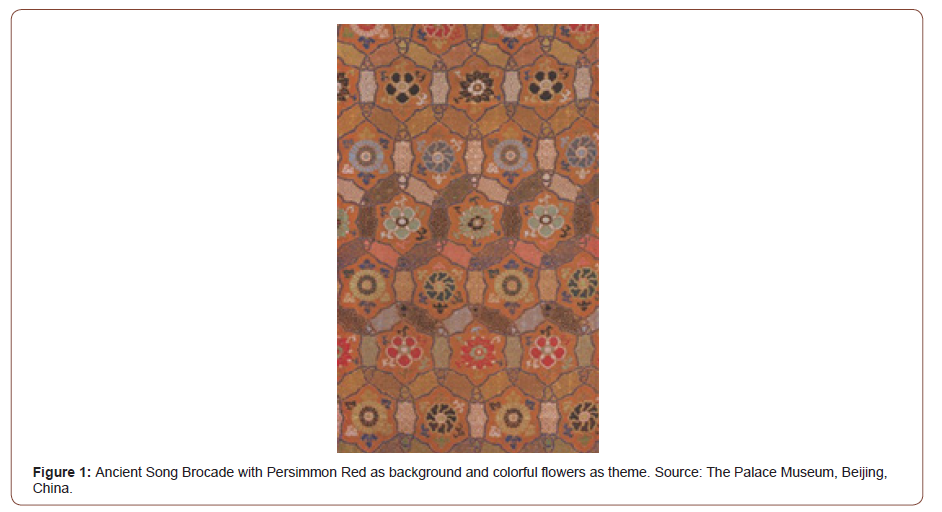

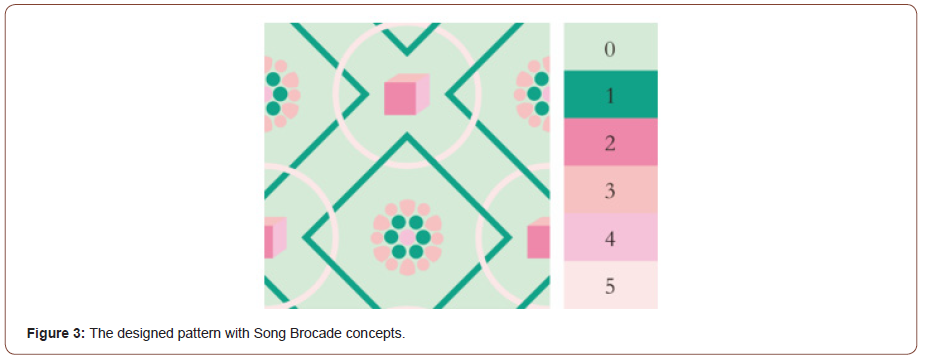
Fabrication of jacquard woven fabrics
The weave structures of traditional Song Brocade are typically achieved by three types of weft yarns and two types of warp yarns [9], which require complicated warping process for high-performance warp yarns. To simplify the weaving process for simplified Song Brocade, the designed weft-backed weave structure consisting of one type of warp yarn and two types of weft yarns is proposed. The arrangement of two types of weft yarns are designed as one type A yarn followed by one type B yarn, which means the ratio of A weft yarn to B weft yarn is 1:1. The color formation mechanism of the fabric surface is as follows. In this weft-backed weave structure, when the warp yarn intertwines with type A weft yarn on the fabric surface to form the one color, type B weft yarn is sunk in the back side of the fabric. In other words, the warp yarn intertwines with either type of A or B weft yarn to form the surface pattern, the other type of weft yarn is hidden on back side of the fabric.
Each color block in the designed pattern of simplified Song Brocade fabric corresponds to one specific weave structure. Thus, there are six weave structures in the designed pattern numbered with color blocks of 0-5 in Figure 3. No. 0 corresponds to background weave structure and Nos. 1-5 are color blocks of designed patterns with different weave structures. The relationship of pattern elements with different color blocks and the corresponding weave structure is shown in Table 1.
Table 1:Characteristic of the patients with AED withdrawal (n=162).

Six designed weave structures are all based on three fundamental weave structures. Their base weave structures include plain weave, 16/3 weft-faced satin weave and 5/3 weft-faced satin weave, etc., as shown in Figure 4. The weave structure of the background No. 0 color block corresponds to No. 0 weave structure (Figure 5a), which is a combination of 5/3 weft-faced satin and plain weave. The weave structure of No. 1 (Figure 5b) combines 16/3 weft-faced satin and plain weave, with designed patterns illustrated by type A weft yarn floats on the surface of the fabric. No. 2 weave structure (Figure 5c) is formed of plain weave and 1/3 left hand twill (LHT). No. 3 (Figure 5d) weave structure is based on two 1/2 LHT weave structures, which form a distinct left-hand slanting texture. Oppositely, two 4/1 right hand twill (RHT) structures are used to construct the weave structure of No. 4 (Figure 5e), which possesses a right-hand slope with steeper angle than that of No.3. To distinguish three different facets of the cube and its three-dimensional effect, Nos. 3 and 4 weave structures are designed with only one type of weft yarn instead of two. In comparison with No. 1 weave structure, No. 5 weave structure has the same base weave structure but the reversed arrangement of type A and B weft yarns (Figure 5f). In other words, type B weft yarn floats are designed to be observed on fabric surface and illustrate the specific pattern of No.5 color block. In order to avoid warp yarns breakages caused by frequent lifting of warp yarns in the weaving process, plain weave is chosen to replace warp-faced weave structure to serve as the back-weave structure of the weft-backed weave. The actual woven fabric samples show that there is no obvious exposure of back-side weft yarns with the plain weave as the back-weave (Figure 5).
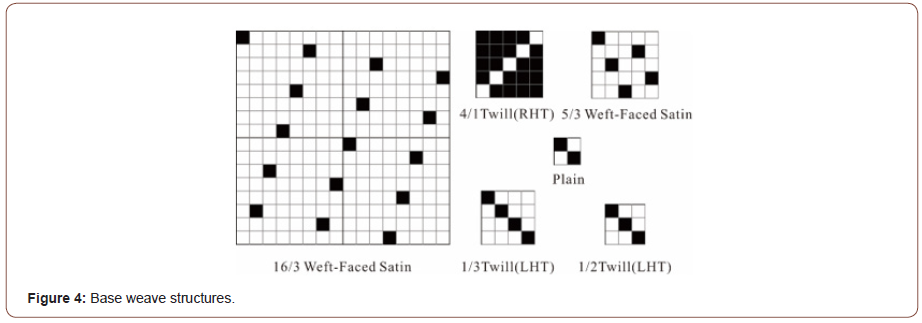
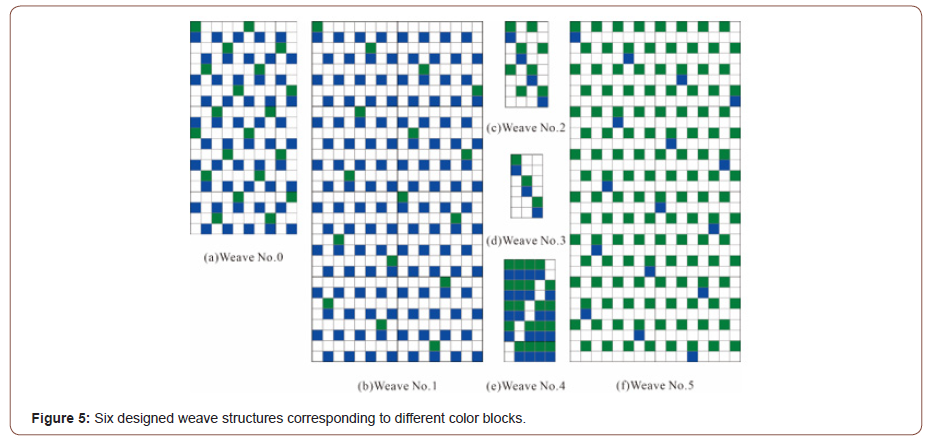
In this work, a total of nine sample fabrics were woven and measured to evaluate the influence of the processing parameters including weft yarn’s fiber content and weft density on the performance of resulting fabrics. The specifications of sample fabrics are shown in Table 2, in which the fabric thickness has been measured according to the standard GB/T 3820-1997 Determination of Thickness of Textiles and Textile Products. The digital photographs woven sample fabrics are shown in Figure 6.


Table 2:The specifications of all jacquard woven fabrics.

Performance Evaluation of Jacquard Woven Fabrics
Moisture absorption and heat performance test
The hygroscopic and thermal performance of nine jacquard woven fabric samples were tested according to GB/T-29866-2013 Textile hygroscopic and thermal performance testing method. Generally, three specimens were prepared for each type of fabric. In detail, the back surfaces of two 60 mm × 100 mm samples were laminated and sewn together along three fabric edges to obtain the combined specimens. The combined specimens were dried in an oven at 105 °C for 3 h and then placed in silica gel desiccator for 1 h under standard atmosphere. The cooled combination specimens were placed into a confined container, which was later put into an environmental charmer (Xiamen Les de Scientific Instruments Co., Ltd, China) (20 ± 0.5 °C, 90 ± 3% humidity) for 30 min to reach equilibrium state. Finally, three combined specimens of each fabric type were connected to three temperature sensors of the environmental charmer, respectively. The fourth temperature sensor was not in contact with any specimen; therefore, it was used for a blank test. The values of four temperature sensors were recorded once per minute. The difference between the temperature of three specimens and the temperature of the blank test recorded each time was calculated and used to yield the final hygroscopic heating temperature curve over 30 min.
Permeability test
The moisture permeability of fabrics was measured according to GB/T 12704.1-2009 Testing method for moisture permeability of textile fabrics Part 1: Moisture absorption method. The fabric specimen with a diameter of 70mm was obtained for each fabric type. The surface side of the specimen was in contact with a moisture permeable cup and covered by a cup cover for subsequent measurement by the water vapor permeability measurement instrument (YG601H-II, Ningbo Textile Instrument Ltd., China) with temperature of 38 ± 0.5 °C, relative humidity of 90 ± 3 % for 1 h. Later the specimen was placed in a silica gel desiccator for 30 min to reach equilibrium state. After weighing, the cup over was removed quickly. The remaining specimen and cup were placed in the water vapor permeability measurement instrument again for 1h and weighed again together with the cup over. For each fabric type, three specimens were measured. The difference between two weighed values of each specimen was referred to as the mass of moisture absorbed by the specimen. The averaged value of each fabric sample was divided by the fabric area in testing and testing time to yield the moisture permeability value.
Results and Discussion
The average and maximum temperature increment values for each fabric type within 30 min are shown in Table 3. The elevated temperature curves are shown in Figure 7. The hygroscopic heating temperature curves for fabrics samples containing 100% acrylic, 100% viscose and acrylic/viscose (60/40, weight/weight, w/w) weft yarns with three different weft densities, respectively are demonstrated in Figure 7a, 7b and 7c, respectively.
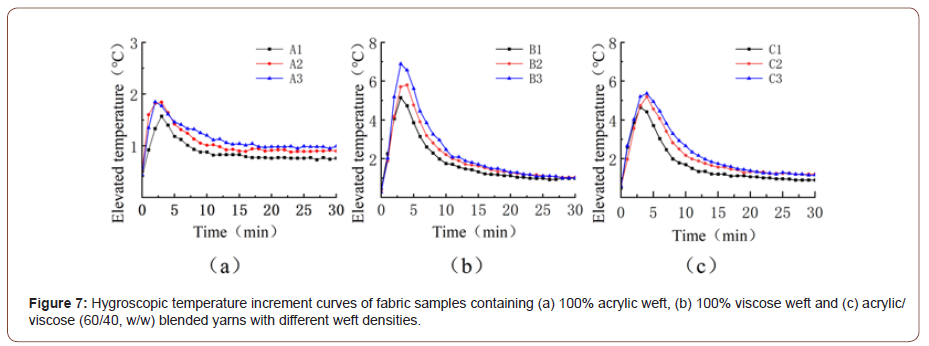
Table 3:The average and maximum temperature increment values of samples within 30min.

According to conservation-of-energy principle, if the potential energy of water vapor remains a constant during its transition from dynamic to static state, then heat energy will be generated [10]. Therefore, it is believed that water vapor in the air with high kinetic energy interacts with polar groups of fibers by forming hydrogen bonding in the moisture absorbing and heat releasing process of fabric. When the weft yarns are 100% acrylic, the heating temperature curves of fabrics (A1-A3) with three different weft densities have the similar trend. In particular, the average and maximum temperature increment values of A3 are 1.2 ℃ and 1.9 ℃ respectively, which are slightly higher than other two samples (A1 and A2). This indicates that the change of weft density has no substantial effect on the hygroscopic and thermal properties of the fabric with 100% acrylic weft yarns. When the weft yarns are 100% viscose, B3 sample with the largest weft density demonstrates better hygroscopic performance and thermal properties than other two samples (B1 and B2): the average and maximum temperature increment values of B3 are 2.4 ℃ and 6.9 ℃, respectively. In comparison, B1 sample with the smallest weft density has the worst performance: the average and maximum temperature increment values are 1.8 ℃ and 5.2 ℃, respectively. This is because 100% viscose weft yarns contain a large number of hydrophilic polar groups, which participate in the formation of hydrogen bonds in the process of moisture absorption and heat release. Thus, fabrics with larger weft density can contain more viscose fibers for more released heat energy. Among fabrics (C1- C3) with acrylic/viscose (60/40, w/w) blended yarns, C3 sample with the largest weft density has the best hygroscopic and thermal properties. Its average and maximum temperature increment values are 2.3 ℃ and 5.4 ℃, respectively. However, C1 sample with the smallest weft density has the worst performance: the average and maximum temperature increment values are 1.7 ℃ and 4.7 ℃, respectively. This phenomenon is related to the content of polar viscose fiber and weft yarn density as well.
In Figure 8, it is shown that A3, B3 and C3 with the same weft density of 72 pick/cm have the best hygroscopic heating performance in their corresponding sample groups of the same weft yarn raw materials. The reason is that a higher weft density results in a tighter fabric, which allows heat to be transferred more slowly into the air during moisture absorbing and heat releasing process. By comparing the hygroscopic heating curves of A3, B3 and C3 samples, B3 has the best hygroscopic heating performance since it contains 100% viscose weft yarns with the highest weft density. A3 contains 100% acrylic weft yarn and the lowest weft density, thus the worst hygroscopic heating performance. In summary, with same weft density, the hydrophilicity of weft yarn directly affects the hygroscopic and thermal properties of the sample fabric.

The moisture permeability of the fabric indicates the exchange capability of water vapor between the human body and ambient air through the fabric. This fabric performance directly affects its wearing comfort. There are main three ways of water vapor exchange through fabric. The first way is that the moisture is transmitted through the air-gap between yarns. Second, moisture is transmitted towards fabric with lower water vapor pressure after moisture absorption of the fiber is completed. Third, water is transmitted by capillary action of fiber. Therefore, the moisture permeability of the fabric is related to the fabric’s weave structure, the warp and weft yarn densities and the polarity of the fiber [11,12]. The moisture permeability of the simplified Song Brocade jacquard woven fabrics has been evaluated to indicate their wearing comfort, as shown in Figure 9.
In Figure 9, among the three fabrics samples (A1-A3) with 100% acrylic weft yarns, A1 has the maximum moisture permeability of 204.4 g/(m2·h), while A2 sample has the minimum value of 189.5 g/ (m2·h). Among the three fabrics samples (B1-B3) with 100% viscose weft yarns, B1 has the maximum moisture permeability of 328.3 g/ (m2·h) and B3 has the minimum value of 222.6 g/(m2·h). Among the three fabrics samples (C1-C3) with acrylic/viscose (60/40, w/w) weft yarns, C1 has the maximum moisture permeability of 245.9 g/(m2·h), whereas C3 has the minimum value of 219.4 g/(m2·h). It can be concluded that fabric with the smallest weft density has the best moisture permeability among the fabrics with the same weft yarn materials. The main reason is that the smaller the weft density, the sparser the yarn arrangement. This is more conducive to the conduction of moisture in the air-gap between the yarns. Among the three fabrics with the same weft density of 36 pick/cm (A1, B1 and C1), B1 has the best moisture permeability and A1 has the worst. This is because B1 with 100% viscose weft yarns is more hygroscopic than A1 with 100% acrylic weft yarns. More content of polar fibers in the fabrics facilitates moisture absorption and vapor transmission.
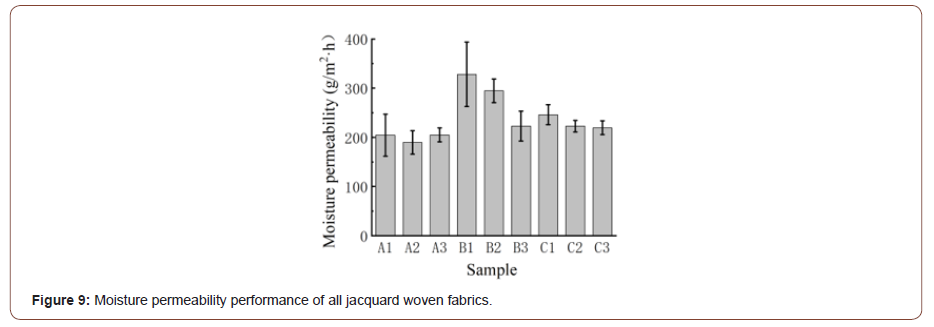
Conclusion
The design and development of jacquard woven fabric utilize traditional Chinese Song Brocade concepts. With the same designed pattern, nine fabrics with different specifications in terms of weft yarn type and weft density have been fabricated. The hygroscopic and thermal performance and moisture permeability of fabrics have been tested. It is shown that fabric with the largest weft density has the best hygroscopic and thermal performance and the fabric with the smallest weft density has the best moisture permeability. Moreover, fabrics containing more hydrophilic fiber content in weft yarns often have better hygroscopic and thermal performance and moisture permeability.
The simplified Song Brocade jacquard woven fabric in this work is innovated in terms of pattern, weave structure and fabric structure. It potentially enables mass production of low-cost Song Brocade for enhanced market competition and better cultural heritage of traditional Chinese Song Brocade.
To read more about this article....Open access Journal of Textile Science & Fashion Technology
Please follow the URL to access more information about this article
To know more about our Journals...Iris Publishers
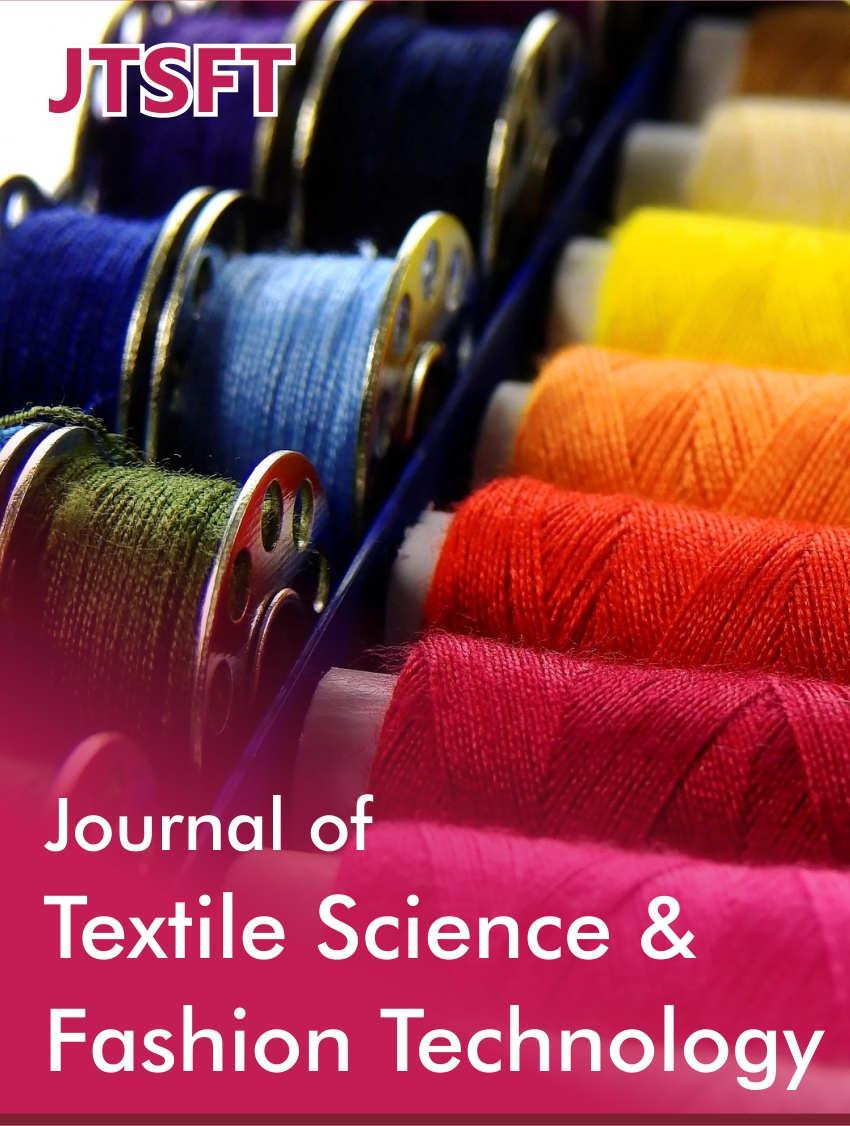




No comments:
Post a Comment